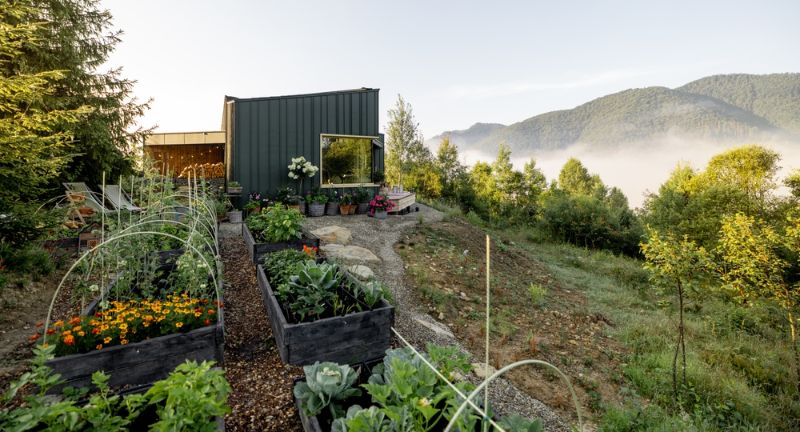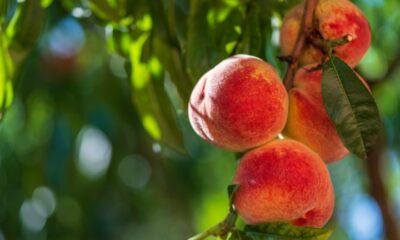LIFESTYLE
30 Practical Ways to Live a More Self-Sufficient Life
Published
1 month agoon

Shutterstock
Living a self-sufficient lifestyle means gaining independence from commercial systems and embracing a more sustainable way of life. By growing your own food, generating your own power, and learning essential skills, you can reduce your reliance on modern conveniences. Self-sufficiency not only saves money but also fosters resilience, environmental responsibility, and personal fulfillment. Whether you live on a rural homestead or in a city apartment, there are many ways to incorporate self-sufficient habits into your daily routine. This guide explores 30 practical steps to help you create a more self-reliant and resourceful lifestyle.
Grow Your Own Food

Shutterstock
Starting a vegetable garden is one of the most fundamental steps toward self-sufficiency. Growing your own food not only saves money but also provides healthier, pesticide-free produce. Even small spaces can be used efficiently with vertical gardening, container planting, or hydroponics. Expanding to fruit trees, berry bushes, and herbs ensures a year-round supply of nutritious food.
Keep Backyard Chickens

Shutterstock
Raising backyard chickens provides a steady supply of fresh eggs while helping control garden pests. Chickens are relatively low-maintenance and can be fed kitchen scraps, reducing food waste. They also produce natural fertilizer, enriching your soil for better plant growth. With proper care, a small flock can contribute significantly to your self-sufficient lifestyle.
Learn Food Preservation Techniques

Shutterstock
Mastering food preservation methods like canning, pickling, fermenting, and dehydrating extends the shelf life of homegrown or store-bought food. These techniques ensure that you have nutritious food even in off-seasons or during emergencies. Learning to properly store grains, beans, and dried foods further enhances your independence from grocery stores. A well-stocked pantry of preserved goods can make your household more resilient.
Collect Rainwater

Shutterstock
Installing a rainwater harvesting system provides a sustainable water source for irrigation, cleaning, and even drinking with proper filtration. It reduces dependency on municipal water supplies and lowers utility bills. Simple setups include rain barrels connected to downspouts, while more advanced systems use underground cisterns and filtration. By capturing and reusing rainwater, you contribute to environmental conservation and self-reliance.
Start Composting

Shutterstock
Composting food scraps and yard waste transforms them into nutrient-rich soil that boosts plant growth. It reduces landfill waste and minimizes reliance on chemical fertilizers. A simple backyard compost bin or worm composting system can handle most organic materials efficiently. Over time, composting improves soil health and enhances sustainability in your home gardening efforts.
Install Solar Panels

Shutterstock
Generating your own electricity with solar panels reduces dependence on the grid and lowers long-term energy costs. Advances in solar technology make installation more affordable and efficient than ever before. A combination of solar power and battery storage can provide energy even during outages. Over time, investing in renewable energy enhances sustainability and self-sufficiency.
Practice Minimalism

Shutterstock
Living with less helps reduce waste and unnecessary spending while prioritizing essential needs. A minimalist approach fosters financial independence by cutting out non-essential purchases. Decluttering and organizing your space creates a more functional and stress-free environment. By focusing on quality over quantity, you can achieve a more sustainable and fulfilling lifestyle.
Make Your Own Cleaning Products

Shutterstock
Homemade cleaning products using vinegar, baking soda, and essential oils are just as effective as commercial alternatives. They eliminate exposure to harsh chemicals and reduce plastic waste from store-bought cleaners. Many DIY cleaners cost only pennies to make and work for multiple surfaces. Learning to make your own ensures a healthier home and a more self-sufficient lifestyle.
Forage for Wild Foods

Shutterstock
Foraging for wild edibles like berries, mushrooms, nuts, and medicinal plants connects you with nature’s bounty. Learning to identify and harvest these foods safely can supplement your diet with nutritious, free ingredients. Many traditional cultures rely on foraging as a sustainable food source. By understanding local flora, you can reduce grocery store dependency and enhance self-reliance.
Raise Livestock

Shutterstock
Raising animals like goats, cows, and pigs provides a source of milk, meat, and other essential products. Properly managed livestock can help regenerate soil and provide natural fertilizer for gardening. While it requires effort and knowledge, small-scale animal husbandry significantly boosts self-sufficiency. Even on a small homestead, animals can play a crucial role in sustainable living.
Learn Basic Carpentry

Shutterstock
Knowing how to build and repair furniture, fences, and household structures saves money and increases independence. Simple woodworking skills allow you to craft custom pieces tailored to your needs. Learning to use tools like saws, drills, and hammers enhances self-reliance. Over time, carpentry becomes an invaluable skill in a self-sufficient lifestyle.
Use Alternative Heating Sources

Shutterstock
Installing a wood stove or pellet stove provides a reliable and renewable heating source. These methods help reduce dependency on electricity or gas, especially in colder months. Sourcing firewood sustainably from fallen trees or managed forests can make heating your home more cost-effective. Learning to properly use and maintain these heating sources ensures long-term energy independence.
Learn Sewing and Mending

Shutterstock
Mending and altering your own clothes saves money and extends the life of your wardrobe. Learning basic sewing skills allows you to repair torn seams, replace buttons, and even create custom garments. Investing in a sewing machine can make projects more efficient and open doors to more advanced DIY clothing repairs. By reducing reliance on fast fashion, you contribute to sustainability and self-sufficiency.
Grow Medicinal Herbs

Shutterstock
Growing medicinal herbs like chamomile, lavender, echinacea, and peppermint provides natural remedies for common ailments. These plants can be used for teas, tinctures, and salves to treat minor health issues. A homegrown herbal garden reduces reliance on store-bought medications and enhances your holistic health approach. Learning about each plant’s benefits and uses helps you develop a natural medicine cabinet.
Start Beekeeping

Shutterstock
Beekeeping provides fresh honey, beeswax, and increased pollination for your garden. Bees are essential for maintaining biodiversity and improving crop yields. A well-maintained hive can produce several pounds of honey annually, reducing the need for store-bought sweeteners. With proper care and knowledge, beekeeping can become a sustainable and rewarding part of a self-sufficient lifestyle.
Learn Basic First Aid

Shutterstock
Knowing how to treat minor injuries, burns, and illnesses without immediate medical assistance is a crucial self-sufficiency skill. A well-stocked first aid kit with bandages, antiseptics, and essential medications can be life-saving. Learning CPR, wound care, and herbal remedies ensures preparedness for emergencies. Self-reliance in healthcare reduces unnecessary trips to the doctor and empowers you to handle medical situations effectively.
Make Your Own Beauty Products

Shutterstock
Homemade beauty products using natural ingredients like coconut oil, shea butter, and essential oils are healthier and more sustainable. DIY lotions, shampoos, and soaps reduce chemical exposure and waste from plastic packaging. Many recipes are simple and cost-effective, allowing for customized skincare and haircare solutions. By making your own products, you take control of what goes on your body while saving money.
Install a Greywater System

Shutterstock
Reusing greywater from sinks, showers, and washing machines can significantly reduce water waste. A properly designed greywater system directs used water to irrigation or toilet flushing, lowering water bills. Simple DIY systems can be installed to filter and distribute water safely. Implementing greywater recycling makes your home more environmentally friendly and resource-efficient.
Build a Root Cellar

Shutterstock
A root cellar naturally preserves fresh produce like potatoes, onions, apples, and carrots without refrigeration. The cool, humid environment slows spoilage and extends the shelf life of food for months. Building a simple underground or basement root cellar can provide long-term food security. This traditional storage method is an invaluable tool for a self-sufficient household.
Learn Basic Auto Maintenance

Shutterstock
Knowing how to perform simple car maintenance tasks like oil changes, brake checks, and tire rotations saves money and prevents breakdowns. Keeping your vehicle in good condition ensures reliability and extends its lifespan. Learning to fix minor issues yourself reduces dependency on mechanics and emergency repairs. Having a basic auto toolkit allows you to address small problems before they become costly.
Harvest Firewood

Shutterstock
Cutting and storing firewood provides a reliable and renewable heating source for winter months. Proper wood seasoning and stacking techniques improve efficiency and reduce smoke pollution. Sustainable firewood harvesting ensures long-term availability while maintaining forest health. Having a steady supply of firewood reduces dependence on fossil fuels and electric heating.
Develop Bartering Skills

Shutterstock
Trading goods and services instead of relying solely on money fosters community and financial independence. Skills like woodworking, gardening, and sewing can be exchanged for food, repairs, or childcare. Bartering networks help strengthen local economies and reduce waste by repurposing goods. Learning how to negotiate fair trades increases self-sufficiency and resourcefulness.
Practice Off-Grid Living

Shutterstock
Living off-grid means reducing or eliminating reliance on public utilities such as electricity, water, and gas. Many people start by using solar or wind power, collecting rainwater, and growing their own food. Practicing off-grid living in small steps can prepare you for emergencies or a fully self-sufficient lifestyle. Even part-time off-grid living fosters resilience and independence from modern infrastructure.
Use Natural Building Materials

Shutterstock
Constructing or renovating using natural materials like straw bales, cob, and reclaimed wood promotes sustainability. These materials often provide better insulation, reducing heating and cooling costs. Many natural building methods are also healthier, free from harmful chemicals found in conventional materials. Learning basic construction skills allows for more affordable and eco-friendly housing solutions.
Learn Hunting and Fishing

Shutterstock
Sourcing your own meat through hunting and fishing reduces reliance on grocery stores. Ethical hunting and sustainable fishing ensure a renewable source of protein. Learning proper techniques, regulations, and conservation practices is key to responsible self-sufficiency. Mastering these skills can provide both food security and a deeper connection to nature.
Create a Community Network

Shutterstock
Building relationships with like-minded individuals fosters support and resource-sharing. A strong community network can provide assistance with food production, bartering, and knowledge exchange. Local self-sufficiency groups or homesteading communities can offer invaluable advice and companionship. Working together enhances resilience and makes self-sufficient living more achievable.
Develop Skills in Home Cooking

Shutterstock
Cooking from scratch ensures control over ingredients, reduces processed food consumption, and saves money. Learning how to bake bread, ferment foods, and prepare homemade meals fosters self-reliance. Preserving family recipes and experimenting with traditional cooking techniques can enhance sustainability. A well-stocked pantry of staple ingredients makes cooking from home easier and more efficient.
Raise Dairy Animals

Shutterstock
Keeping goats or cows for milk provides fresh dairy products like cheese, butter, and yogurt. Raising dairy animals reduces dependence on store-bought dairy and ensures higher quality products. Proper care and milking routines are essential for maintaining a healthy and productive animal. Owning dairy animals can be a rewarding addition to a self-sufficient lifestyle.
Save and Exchange Seeds

Shutterstock
Saving seeds from your best crops ensures future planting without reliance on commercial seed companies. Heirloom and open-pollinated seeds preserve genetic diversity and improve crop resilience. Participating in seed exchanges with fellow gardeners promotes biodiversity and resource sharing. Proper seed storage techniques keep seeds viable for multiple growing seasons.
Make Your Own Household Items

Shutterstock
Creating homemade household items like candles, soap, and reusable cloths reduces waste and saves money. Many DIY products use simple, natural ingredients that are safer for your home and the environment. Learning traditional crafting techniques fosters creativity and resourcefulness. Making your own essentials enhances self-sufficiency and minimizes reliance on store-bought goods.
Conclusion

Shutterstock
Embracing a self-sufficient lifestyle is a journey that requires patience, learning, and dedication, but the rewards are immeasurable. By taking small steps toward growing your own food, conserving resources, and developing practical skills, you can build a more independent and sustainable way of living. Whether you implement one or all of these 30 strategies, every action brings you closer to greater self-reliance. The more you practice self-sufficiency, the more confident and empowered you will become in managing your own needs. Ultimately, living self-sufficiently is not just about survival—it’s about thriving with greater freedom, security, and harmony with the world around you.
Related Topics:

More From Lifestylogy
-


25 Ways To Incorporate More Magnesium Into Your Diet
-


25 Flowers That Create The Most Beautiful And Long-Lasting Bouquets
-


29 of the Strangest Fears That People Actually Have
-


Nostalgic Reads: 25 Children’s Books Every Adult Should Read Again
-


28 Inspiring Ideas to Kickstart Your Best Year Yet
-


25 Must-Read Books to Inspire and Uplift Women
-


Why You Should Eat More Peaches
-


20 Fall Fashion Trends For 2024 That You’ll See Everywhere
-


26 Reasons Why You Should Collect Stuffed Animals